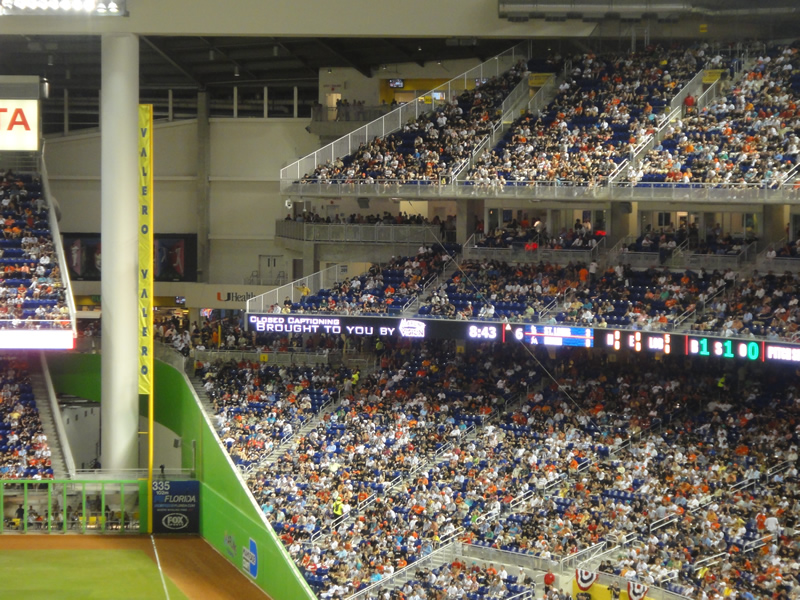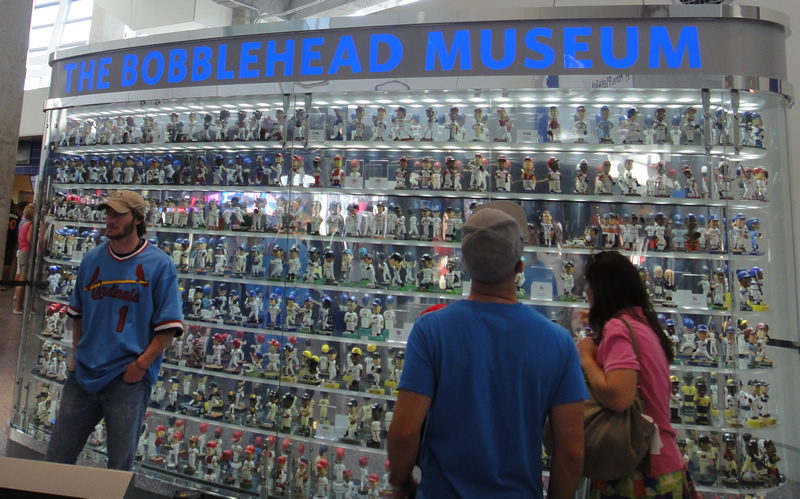The Florida Marlins - check that - the Miami Marlins - opened up Marlins Park on Wednesday, April 4, 2012, in front of 36,601 fans. With the temperature just shy of 80 degrees and a slight breeze blowing through the ballpark, it was a great scene for welcoming the 2012 World Series Champion Cardinals into the Marlins' new home. Read the RateYourSeats.com review of Marlins Park to find the best and worst seats, learn where the sushi is, see pictures of the Bobblehead Museum and get our general thoughts on the ballpark.
The Stadium
The exterior of the stadium lacks any significant character for a baseball stadium. Upon approaching Marlins Park, we thought the stadium was behind the large, dull convention center. The large, dull convention center turned out to be the stadium.
What the stadium lacks in exterior character, it more than makes up for with interior charm and uniqueness. The home run sculpture in center field is clearly the most distinguishable characteristic. Bright colors, sun, water, palm trees and shells provide the backdrop for a few flying marlins (the fish, not the players). It looks out of place at a Major League park and would be better off as a mural in a kid's playroom, but it's an interesting sight to see and a part of the ballpark that hopefully sticks around.
Besides for the sculpture in CF, the most noticeable aspect of the ballpark is the bright colors. The outfield walls are painted in a bright green that you wouldn't dare put in a baseball stadium outside of South Florida (unless you're in Japan). Additionally, backsplash-like tiles can be found on many walls inside the stadium. This is a feature not found in many baseball stadiums -- and for good reason -- it's ugly and makes part of the stadium look like a re-modeled kitchen.
 If you're sitting down the 3rd base line in the 300 level, you have the best view of two of the best aspects of the ballpark -- the jumbotron and the view of downtown Miami. The jumbotron appears higher up than in most stadiums, which is why sitting in the 300 level provides a perfect view. The video quality is fantastic and the board is a great size for a baseball stadium. The operator; however, could use a little help on what is relevant during game situations. With nobody on base, it is unimportant to fans that Josh Johnson has thrown 58 double plays in his career as a starter. Irrelevant statistics like this were constantly taking up space on the big board. The view of downtown Miami was just as impressive as the crispness of the video board. Besides for about a dozen pillars, the opening to downtown Miami behind the left-field seats is unobstructed and massive. Stadiums with retractable roofs feel very enclosed even when the roof is open, but Marlins Park easily overcomes this drawback.
If you're sitting down the 3rd base line in the 300 level, you have the best view of two of the best aspects of the ballpark -- the jumbotron and the view of downtown Miami. The jumbotron appears higher up than in most stadiums, which is why sitting in the 300 level provides a perfect view. The video quality is fantastic and the board is a great size for a baseball stadium. The operator; however, could use a little help on what is relevant during game situations. With nobody on base, it is unimportant to fans that Josh Johnson has thrown 58 double plays in his career as a starter. Irrelevant statistics like this were constantly taking up space on the big board. The view of downtown Miami was just as impressive as the crispness of the video board. Besides for about a dozen pillars, the opening to downtown Miami behind the left-field seats is unobstructed and massive. Stadiums with retractable roofs feel very enclosed even when the roof is open, but Marlins Park easily overcomes this drawback.
The Food
 The Marlins might be the only team that serves their mascot at a concession stand -- well, almost. We did not see marlin at any of the food stands, but you will find a sushi stand on the first base side near Section 11. We did not sample the fare, but the prices ranged from $8.00 for a Mega Roll to $14.00 for Assorted Sashimi or a Nigiri and Roll Combo.
The Marlins might be the only team that serves their mascot at a concession stand -- well, almost. We did not see marlin at any of the food stands, but you will find a sushi stand on the first base side near Section 11. We did not sample the fare, but the prices ranged from $8.00 for a Mega Roll to $14.00 for Assorted Sashimi or a Nigiri and Roll Combo.
We only saw one sushi stand on the lower level, but we saw plenty of concession stands called "Burger 305" (305 is South Florida's area code). Burgers (including vegetarian), chicken fingers and french fries are the attraction here -- just as you would expect at a baseball stadium. Burgers were $8.00-$9.50, though we opted for the $9.00 chicken finger basket with fries. The chicken fingers were so-so, but the fries were pretty good (and plentiful). The nachos were much better than traditional ballpark nachos and made a great snack. We also purchased the $8.00 souvenir soda cup which gets you free refills throughout the game. This is a great deal if you're there with a family and have aisle seats. Beer prices varied throughout the stadium. At some stands, domestic (Miller Lite and Bud Light) beer started at $8 and at others it was $8.50. From the vendors, bottles of beer were $9.00.
For kosher options, visit the Kosher Korner near Section 1 (right field).
Overall, the food options were somewhat unimaginative and the beer prices are too high for a stadium that is already going to struggle to fill seats.
The Seats
The seating at Marlins Park is what separates it from most stadiums. This is a true baseball fan's paradise in terms of actually watching the game. Every seat we could see was angled such that it would have the best view of home plate. This is most apparent when looking down the right-field line. Every section in the first, second and third decks is slightly turned at a unique angle to give fans a great view of the action. At most stadiums, seats down the first-base line leave fans staring off into left-field. This is not the case at new Marlins Park. 
In addition to the angle of the seats, we were particularly impressed with the overhangs created by the second and third decks. This allows fans in the second and third decks to be as close to the field as possible. The Marlins Park overhangs are attractive, useful and do not obstruct any views in the lower deck. We went all around the lower bowl and could not find any seats where these overhangs caused an issue.
While the overhangs did not cause any issues with seating, the railings in some of the sections in the 3rd deck cause considerable issues. It took the Marlins 6+ innings to record their first hit in their new ballpark, and it took RateYourSeats.com about six seconds to find the worst seats in the stadium: Section 319, Row B, Seats 1-2. There are two railings that block the view of home plate from your seat. Whether tall or short, one of these railings is going to obstruct your view of the batter-pitcher exchange and balls hit in the infield. Avoid these seats at all costs and similar seats in Section 310. They are not worth the headache -- or the back-ache that comes with having to lean forward for nine innings to see through or over the railings. For a new stadium, this is unacceptable, and the Marlins should either remove these seats or sell them at a severe discount.
Finally, for seats that have absolutely no need for a railing, check out Sections FL4-FL8. These are the famous seats with the aquarium separating the seats from the field. The aquarium is stocked with about 50 exotic fish and the glass is a bulletproof glass that should be able to withstand its share of foul balls. These Diamond Club seats come with other perks, including all-inclusive high-end dining, a private entrance -- and the closest seats are only 47 feet from home plate. But it's the aquarium that makes these seats one-of-a-kind.
Bobblehead Museum
 Located near Section 15 (behind home plate), the Bobblehead Museum is a collection of about 600 bobbleheads from every Major League Baseball team. Each team is represented with about 20 or so bobbleheads. On the front side of the case you will find bobblehead dolls for National League teams, and on the backside there are bobbleheads for American League teams. There is a lot of walking space on the concourse, but for some reason the "Museum" is pushed back near the wall which it difficult to get around and see all of the American League bobbleheads. If you have an extra ten minutes at the ballpark, it might be worth stopping by to see.
Located near Section 15 (behind home plate), the Bobblehead Museum is a collection of about 600 bobbleheads from every Major League Baseball team. Each team is represented with about 20 or so bobbleheads. On the front side of the case you will find bobblehead dolls for National League teams, and on the backside there are bobbleheads for American League teams. There is a lot of walking space on the concourse, but for some reason the "Museum" is pushed back near the wall which it difficult to get around and see all of the American League bobbleheads. If you have an extra ten minutes at the ballpark, it might be worth stopping by to see.
Overall Impressions
Overall, Marlins Park gets high grades for its seating and view of downtown Miami. We recommend seats in the 200 or 300 level down the third-base line for spectacular views outside of the stadium and a great look at the video board. There were thousands of unoccupied seats on Opening Day, and the rest of the 2012 season should be the same way. This should create affordable ticket prices for a team that will likely be in the playoff hunt all season.
Marlins Park Pictures (we took more than 200 pictures of the stadium and the seating)

